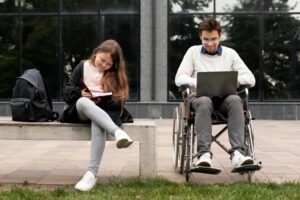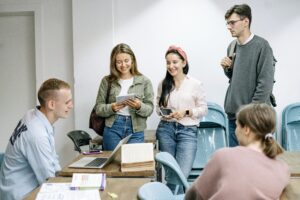Tailoring to students’ needs, fostering creativity and engaging students
Materials
1. Introduction
Tailoring to students’ needs is one of the key points of inclusive educational pedagogy. Differentiation and individualization of teaching support recognition of, and response to diverse needs of students.
Universal Design for Learning (UDL) has been increasingly used to support differentiation in the classroom, as its goal is to use a variety of teaching methods and resources to remove barriers to learning. Although it may sound like UDL is about finding one way to teach all students, it is about building in flexibility that supports adjustments for every person’s needs. (Morin, 2024a).
Differentiated instruction (DI) further elaborates teaching based on recognition of students’ individual strengths and needs, which enhances engagement and creativity and, in the end, ensures more effective teaching and learning practice. It plays a vital role in higher education by a) promoting students’ success despite challenges in learning, b) fostering inclusivity, and c) preparing students to thrive in a diverse and dynamic global society.
1.1 Overview of the lesson
This lesson will explore the core ideas behind Universal Design for Learning (UDL) and Differentiated Instruction (DI) in the context of differentiation and individualization in inclusive education. It will then further explore the concept of differentiated instruction, its key elements and the strategies of differentiation that support inclusive teaching.
By the end of this unit, you will be able to:
- Explain what differentiated instruction is.
- Describe the key elements of classroom differentiation.
- Provide examples of differentiation strategies that enhance students’ creativity and engagement.
- Apply these strategies effectively in your own lessons.
2. Differentiation and individualization in inclusive education
The differentiation and individualization as an overall didactic approach attempts to ensure educational justice in the sense of a participatory fairness. Based on the recognition of the plurality of students within a class community, this requires the teachers’ didactic reactions and adaptations to students’ individual needs. (Lindner & Schwab, 2020).
Differentiation can be understood as “a varied preparation and design of inclusive teaching practice in a reactive way by reacting to the needs of students” (Lindner & Schwab, 2020).
Differentiation and individualization can be achieved using principles of Universal Design for Learning (UDL) and Differentiated Instruction (DI).
2.1 Universal Design for Learning
UDL is a tool that aims to ensure that a lesson is accessible and equitable to a wide variety of learners. By implementing UDL principles a teacher may start with general accessibility and work on any adjustment that might be needed along the way depending on the variety of students’ needs (despite sometimes conflicting).
The three main UDL principles are: 1) Representation (information are offered in more than one format), 2) Action and expression (there is more than one way to interact with the material and to demonstrate what the students have learned), 3) Engagement (multiple ways are considered to motivate students). (Morin, 2024b).
2.2 Differentiated instruction
Differentiated instruction (DI) is a systematic approach to planning curriculum and instruction for academically diverse learners that focuses on modifying 1) content, 2) process, 3) product, and 4) learning environments in response to students’ strengths and needs. This method acknowledges that students have varying backgrounds, readiness levels, interests, and learning profiles, and it seeks to provide multiple paths to learning so that all students can achieve success. (Tomlinson, 2001; Heacox, 2012; Sousa & Tomlinson, 2018).
Differentiated instruction is considered as one of the essential means to effective education for all students including those with disabilities. It involves responding effectively to the differences that exist among learners in the classroom. It allows educators to adapt their teaching to suit different learning needs, including the use of visual aids and interactive tasks. (Strogilos, 2018).
The key points and benefits of differentiated instruction are:
- Addressing Diverse Student Populations: Higher education classrooms often comprise students with varying backgrounds, experiences, and levels of prior knowledge. Differentiated instruction recognizes this diversity and provides flexible teaching approaches to accommodate individual learning needs.
- Promoting Inclusivity: By embracing differentiation, educators ensure that all students, regardless of their starting points or learning abilities, have access to meaningful learning experiences. This promotes equity and inclusion in the classroom, creating opportunities for every student to succeed.
- Enhancing Engagement and Motivation: Tailoring instruction to match students’ interests, strengths, and preferences increases engagement and motivation. When students feel that their learning experiences are relevant and personalized, they are more likely to actively participate and remain invested in their education.
- Developing Critical Thinking and Problem-Solving Skills: Differentiated instruction encourages students to think critically, solve problems creatively, and apply concepts in diverse contexts. By providing varied learning experiences and challenges, educators empower students to develop essential skills for success in their academic and professional lives.
- Preparing Students for Real-World Challenges: In today’s rapidly changing world, adaptability and resilience are crucial. Differentiated instruction equips students with the ability to navigate complex situations, collaborate effectively, and continue learning beyond the classroom, preparing them for the challenges they will encounter in their future careers and endeavors.
Despite its perceived importance, research has shown the absence or inconsistent use of differentiated instruction. The main challenges in its application, and at the same time the areas that need more attention in the future, are:
- The lack of educators’ knowledge necessary to extend and differentiate the curriculum content areas;
- The lack of time to adjust the curriculum;
- The difficulties to locate and effectively use the appropriate resources;
- The lack of educators’ skills in recognizing the students needs and the way they differ in how they learn;
- The lack of curriculum modifications and consequently opportunities for individualized approach for students with disabilities in mainstream classrooms.
2.3 Key elements of classroom differentiation
Key elements of differentiated instruction in inclusive education include:
- Content: Differentiating what students learn. This can involve providing different materials for students based on their cognitive ability, reading levels, background knowledge, or interests. For example, a teacher might use simpler texts for students who struggle with reading and more complex ones for advanced readers, while ensuring all texts address the same essential concepts.
- Process: Differentiating how students learn. This involves varying the ways students engage with the material, including how material is adapted to diverse needs. For instance, some students might learn better through hands-on activities, while others might benefit from working in groups or using visual aids. For inclusive teaching it is also essential to offer diverse time options and provide the same teaching content in multiple ways in order to cover diverse learning needs (e.g. visual, auditory and tactile input).
- Product: Differentiating how students demonstrate their learning. This allows students to show what they have learned in various ways. Some might write a paper, create a presentation, or build a model, depending on their capacities, strengths and preferences.
- Learning Environment: Differentiating the classroom setting to support individual learning needs. This might involve creating quiet areas for independent work, arranging desks to facilitate group collaboration, or providing materials that cater to different learning styles.
DI is about getting to know students and making decisions based on strengths and needs. It requires ongoing assessment and flexibility. Teachers must regularly assess students’ needs and progress to adjust instruction accordingly. It also involves a shift from a one-size-fits-all approach to a more student-centered model, where the teacher acts as a facilitator, guiding each student along their unique learning path.
3. Enhancing engagement and creativity with differentiated instruction
In previous section, we examined the fundamental elements, key benefits and main challenges in applying differentiated instruction into practice. In this section we are going to explore specific strategies for applying differentiation to enhance creativity and engagement in the classroom.
1) Creativity in Differentiated Instruction
Creativity is a vital skill that empowers students to think critically, solve problems innovatively, and express themselves uniquely. Here are some strategies to promote creativity through differentiation:
- Open-Ended Tasks: Provide open-ended tasks or prompts that allow for multiple interpretations and solutions. For example, ask students to design a solution to a real-world problem or create a piece of art inspired by a theme or concept from the curriculum.
- Creative Projects: Assign creative projects that encourage students to apply their learning in imaginative ways. For instance, students could write and perform a skit, compose a song, or create a digital presentation to demonstrate their understanding of a topic.
- Choice-Based Activities: Offer choice-based activities that allow students to explore topics of interest or pursue projects aligned with their passions. This promotes intrinsic motivation and ownership of learning outcomes.
- Cross-Curricular Connections: Encourage interdisciplinary connections by integrating different subject areas into creative projects. For example, students studying history could create a multimedia presentation that incorporates elements of art, music, and literature from the relevant time period.
Practical Tips:
- Get to know your students’ strengths and interests to stimulate their creativity.
- Provide a variety of materials and resources to support creative exploration, such as art supplies, digital tools, and access to multimedia resources.
- Incorporate brainstorming sessions and collaborative activities to generate ideas and foster creativity in group settings.
- Celebrate and showcase students’ creative work through exhibitions, performances, or digital portfolios to recognize their achievements and inspire others.
2) Engagement through Differentiation
Engagement is essential for promoting active participation and deep learning among students. Here are some strategies to enhance engagement through differentiation:
- Personalized Learning Pathways: Offer personalized learning pathways that allow students to progress at their own pace and focus on areas of interest. This could involve differentiated assignments, self-paced modules, or individualized learning contracts.
- Interactive Learning Activities: Design interactive and hands-on activities that encourage students to actively engage with the content. For example, use simulations, experiments, or role-playing exercises to bring concepts to life and make learning more memorable.
- Technology Integration: Integrate technology tools and resources to enhance engagement and interactivity. Virtual reality simulations, educational games, and multimedia presentations can captivate students’ attention and provide opportunities for exploration and discovery.
- Real-World Connections: Make learning relevant by connecting classroom content to real-world issues, challenges, and experiences. Encourage students to explore how course concepts apply to their lives, communities, and future careers.
Practical Tips:
- Get to know your students’ barriers that may hinder their interaction with the materials and information provided.
- Incorporate movement breaks, energizers, and kinesthetic activities to keep students physically active and engaged during lessons.
- Use formative assessment strategies, such as exit tickets, polls, and quizzes, to gauge student understanding and adjust instruction accordingly in real-time.
- Foster a positive and supportive classroom culture where students feel valued, respected, and encouraged to take risks and share their ideas.
We have explored strategies for enhancing creativity and engagement through differentiated instruction. By incorporating these strategies into your teaching practice, you can create a dynamic and interactive learning experience for all students with respect to their strengths and needs.
4. Conclusion
In this lesson, we discussed the importance of understanding the students’ strengths, needs and interests. We covered differentiation and individualisation that support inclusive teaching and learning. Specifically, we covered:
- The meaning and the basic principles of Universal Design for Learning (UDL),
- The meaning and the key elements of Differentiated Instruction (DI),
- The differentiation strategies that support creativity and engagement,
- Practical tips for enhanced creativity and engagement in the classroom.
This lesson focused on overall UDL and DI principles and provided some practical tips on how to use differentiated instruction in practice. However, achieving truly inclusive education when considering students with disabilities requires specific knowledge about a wide variety of options and adaptations that can be incorporated for making the teaching content, process, environment and learning accessible.
5. References
- Lindner, K.-T., & Schwab, S. (2020). Differentiation and individualisation in inclusive education: a systematic review and narrative synthesis. International Journal of Inclusive Education, 1–21. https://doi.org/10.1080/13603116.2020.1813450
- Strogilos, V. (2018). The value of differentiated instruction in the inclusion of students with special needs/ disabilities in mainstream schools. SHS Web of Conferences, 42, 00003. https://doi.org/10.1051/shsconf/20184200003
- Tomlinson, C. A. (2001). “How to Differentiate Instruction in Mixed-Ability Classrooms.” Alexandria, VA: ASCD. Carol Ann Tomlinson is a leading expert in the field of differentiated instruction, and her works are foundational to understanding the approach.
- Heacox, D. (2012). “Differentiating Instruction in the Regular Classroom: How to Reach and Teach All Learners.” Minneapolis, MN: Free Spirit Publishing. Diane Heacox provides practical strategies and examples for implementing differentiated instruction in the classroom.
- Sousa, D. A., & Tomlinson, C. A. (2018). “Differentiation and the Brain: How Neuroscience Supports the Learner-Friendly Classroom.” Bloomington, IN: Solution Tree Press. This book combines neuroscience and differentiated instruction principles to enhance learning and teaching.
- Morin, A. (2024a). “What is Universal Design for Learning (UDL)?” Retrieved from: https://www.understood.org/en/articles/universal-design-for-learning-what-it-is-and-how-it-works
Morin, A. (2024b). “Universal Design for Learning (UDL): What you need to know” Retrieved from: https://www.readingrockets.org/topics/assistive-technology/articles/universal-design-learning-udl-what-you-need-know
6. Pedagogy: Implementation in the classroom
Pedagogy: Implementation in the classroom
20 min
After completing this unit, the learner will be able to:
- explain what is differentiated instructions,
- describe the elements of classroom differentiation,
- give examples of differentiation strategies for enhancing students’ creativity and engagement,
- apply differentiation strategies to their lessons.
Digital education, Inclusion, Differentiated Instruction, Students’ needs, Creativity, Students’ engagement








Funded by the European Union. Views and opinions expressed are however those of the author(s) only and do not necessarily reflect those of the European Union or the European Education and Culture Executive Agency (EACEA). Neither the European Union nor EACEA can be held responsible for them (2022- 1 -SI01 -KA220-HED-000088368).






